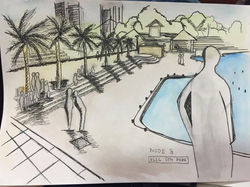
RE-PRESENTING PLACE CLS60103
Project 1a: Writing Research Proposal
In this project, we are able to pick our own site within the Kuala Lumpur Golden Triangle. For my group, we have choosen the famous KLCC area as our case study. Before the site visit commence, we are to choose and propose from the theme of the list below with our theme being Architectural and urban language.
1) Urban veranda : interaction between streets, pedestrian walkways and the shop-fronts(veranda as a place for people to mingle, rest)
2) Urban streetscape : back lanes, signage, pedestrian network, courtyards, and permeable/impermeable surroundings.
3) Ripples of life : Religious/Spiritual, political, cultural aspects of the city and rural areas identity.
4) Hybrid morphology : transition or overlapping between old and new architecture and culture, new interventions.
5) Architectural and urban language : facades, style, massing, scale, colour, texture, materials, ornamentation, nodes, grids, courtyards, etc.
6) Constructed landscapes : How architecture becomes a vehicle in creating and evolving relationship with the users of the environment.
Group Proposal
Project 1b: Experience & Capture
In this project, we are to collect data regarding of our site. The data has to be in accord with our chosen topic which is Architectural and urban language. Therefore, an actual studio tour need to be conducted. The methodology of our collection of data involves taking meaningful photos on the spot and also research via world wide web afterwards.
There are two methods of documentation:
1. .A-4 Sketch book (with captions or annotations) which contains a documentation of our experiences with our chosen theme. Experiences and understanding of the site should be documented in a journal, and submitted as an appendix to our final exhibition submission.
2.Photo book (with captions or annotations) At least (10) photographs which clearly and creatively captured in regard to our chosen topic. These photographs should be well composed and deliver the perception of the theme.
Learning Outcomes of this Project
1. Write a short research proposal.
2. Document the urban and cultural facets of the city in relation to architecture and the built environment.
3. Analyze and interpret the urban and cultural facets of the city in relation to architecture and the built environment.
4. Produce creative production to visualize and represent research outcomes.
Sketch Book
 13296056_10154192075543718_1618148202_n |  13293140_10154192075548718_1744454417_n |
|---|---|
 13293011_10154192075563718_688878097_n |  13292983_10154192075578718_1357754649_n |
 13292804_10154192075568718_721143643_n |  13288911_10154192075583718_2060483667_n |
 13285805_10154192075573718_1065224062_n |  13285728_10154192075598718_1102405671_n |
 13282108_10154192075608718_720859518_n |  13278053_10154192075603718_353964883_n |
 13275698_10154192075558718_1176590264_n |  13277966_10154192075593718_567260119_n |
 13275899_10154192075553718_1428568113_n |
Photo Book









Project 2: Analysis and Interpretation
Upon the return of our tour around our site, we need to analyze and interpret the documentation we have gathered during the study tour and with the aid of world wide web for additional research and information. For the submission, we are to produce a research poster based on our theme.
Learning Outcomes of this Project
1. Analyze and interpret the urban and cultural facets of the city in relation to architecture and the built environment
Presentation Poster

Project 3 Presentation +Exhibition
For the final project, we are required to materialize our own understanding and analysis into a creative production for the final exhibition, which manifests and visualizes from our own interpretation. Creative production refers to the visualization of our research into tangible model or artwork with a creative and experimental manner.
Learning Outcome of this Project
1. Analyze and interpret the urban and cultural freed of the city in relation to architecture and the built environment
Final Model
